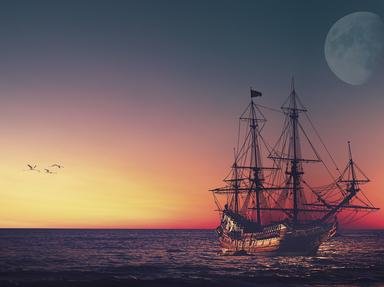Quiz Answer Key and Fun Facts
1. The first circumnavigator was, as you all know, the Portuguese explorer Ferdinand Magellan. He managed to convince the young king of Spain - Charles V - to grant him the chance of finding a new way to the Spice Islands. He set sail from Seville on September 20, 1519. After he eventually found the long expected southern strait (that would later bear his name), his fleet faced the seas of an ocean discovered only seven years before his expedition, by explorer Nunez de Balboa. Magellan named this ocean "Pacific", meaning...
2. The second circumnavigation was undertaken by one of the greatest English sea captains ever - Sir Francis Drake. Although a privateer, the services he brought to the English Crown proved inestimable. The voyage he successfully led from beginning (1577) to end (1580) involved his remarkable navigating skills as well as his piracy experience. What was the name of the ship which made it all possible?
3. From the second half of the 17th century up to the first decade of the 18th century the oceans were terrorized by buccaneers and pirates. From their "headquarters" in Tortuga Island the pirates ventured in great expeditions in search for the rich Spanish galleons, part of these voyages ending up as circumnavigations with important geographical discoveries. Moreover, one particular buccaneer even had literary talent as his memoires describing his travels around the world are considered to be one of the best travel writings ever. Who am I talking about?
4. Captain James Cook's journeys around the world may be the most prolific of all circumnavigations regarding the geographical discoveries. In his three long voyages he charted most of the islands in the Pacific Ocean and he also proved that there was neither a southern continent beneath polar latitudes nor a northern strait between the Pacific and the Atlantic. Although he criss-crossed the Pacific, he never reached one particular archipelago:
5. During the 18th and 19th century, the circumnavigations became more frequent. With Krusenstern's expedition, the Russians also engaged in the circumnavigation race. One of the most important Russian voyages explored the remote waters around the Antarctic continent which were not given much interest since Cook's travels. This expedition was commanded by:
6. With most of the geographical discoveries made, the circumnavigators changed their goals toward gathering scientific information. This is the case of Fitzroy's expedition. His ship, the "Beagle" was endowed with remarkable scientific equipment whose value may have been surpassed only by one particular member of the crew: Charles Darwin. Which of the following locations was studied by the young naturalist?
7. Travelling around the world aboard small ships exerted a strong attraction even since the 19th century. The navigator referred to in this question accomplished the first solitary circumnavigation recorded in history:
8. The 20th century brought a new way of circumnavigating the world: flight. In the early days of flight, nobody believed that this would be possible but things seem to evolve so fast... So eventually, the 'ultimate' circumnavigation became the space flight around Earth in orbit. Who had this privilege for the first time?
9. Circumnavigating the globe is still a tempting adventure for many people. Some of them are pioneers by experimenting with new ways of achieving this, others are just trying to break records. What record do you think the Swiss Betrand Piccard and his British team-mate Brian Jones established ?
10. This last question may seem a little bit odd because it's about Jules Verne and he had never gone too far from home. Still, he wrote probably the best book ever about a circumnavigation of the world.
How long did it take his famous character, Phileas Fogg to travel around the world?
Source: Author
Mr5
This quiz was reviewed by FunTrivia editor
thejazzkickazz before going online.
Any errors found in FunTrivia content are routinely corrected through our feedback system.

